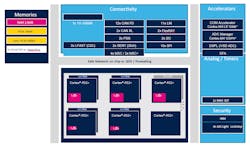Automotive MCUs Eye EV Platform Integration
To manage the complexity and performance of new features automakers are adding to vehicles (such as electrification, advanced safety, assisted and automated driving), they’re transitioning to software-defined vehicles for their next-generation platforms. This transition requires a revamping of the car’s architecture.
Key changes include moving from many electrical control units (ECUs) that each manage a small subsystem to domain or zone controllers that combine multiple functions. Such controllers also must manage the consolidation of software from across a wide range of vehicle systems.
Safety and performance require a new generation of automotive-grade MCUs that enable greater processing performance and integration of key functions. STMicroelectronics’ new Stellar P6 automotive MCUs target the coming electrified drivetrains and over-the-air updatable systems that form the foundation of next-generation EVs.
In software-defined vehicles fully driven by electronics systems, the Stellar P6 family was created to deliver fully synchronized operations and secure over-the-air software upgrades of all systems for both maintenance and continued performance improvement.
What is CAN XL?
These also are the industry’s first devices for model year 2024 vehicles to integrate the new CAN XL (Controller Area Network Extra Long) in-car communication standard. This technology enables new vehicle platforms to handle growing data flows so that the car can operate at peak performance.
CAN XL, the third generation of the CAN data-link layer (DLL), is similar to CAN FD, with two bit-timing settings specified. The data-field length goes from 1 byte to 2048 bytes. New is the separation of the CAN-ID field into an 11-bit priority field and a 32-bit acceptance field.
For the XL data phase, the CAN XL DLL provides information on how to switch from the nominal bit rate to the XL data-phase bit rate and vice versa, and how to switch the CAN transceiver mode from Arbitration mode to Data TX Mode/Data RX Mode or vice versa (PWM coding). The PWM coding allows bit rates of 10 Mb/s and more depending on the physical network design.
CAN XL is intended for backbone and sub-backbone network applications. It’s designed for an easy integration into TCP/IP network systems.
Inside the P6
ST’s Stellar P6 MCUs contain up to six Arm Cortex-R52 processor cores, some operating in lockstep and some in split-lock mode to provide failsafe redundancy. As a result, the new devices are able to deliver high performance, real-time determinism, and upgradability for next-generation automotive drivetrains, electrification solutions, and domain-oriented systems.
Stellar P6 manages hardware virtualization using Cortex-R52 features and firewalls. This simplifies the development and integration of multiple-source software on the same chip while ensuring safe isolation and optimizing performance.
“The real-time, power-efficient Stellar P6 automotive microcontrollers combine advanced integration of motion-control and energy-management domains with actuation capabilities, ensuring a smooth shift from traditional ICEs/EVs to new drive-traction architectural patterns of software-defined vehicles,” said Luca Rodeschini, Automotive and Discrete Vice President, Strategic Business Development and Automotive Processing and RF General Manager, STMicroelectronics.
Manufactured in ST’s wafer fabs using 28-nm FD-SOI technology, the Stellar P6 embeds up to 20 MB of phase-change (non-volatile) memory (PCM). ST’s PCM also delivers faster access time through single-bit overwrite, a feature unavailable in flash. In addition, over-the-air updates with no downtime saves memory by dynamically allocating memory space to the new downloaded software image until it’s validated.
Security Measures
With such a configuration, Stellar P6 microcontrollers can store up to 2x 20 MB for OTA reprogramming purposes, providing significant savings in terms of memory needs. They further provide high-speed security cryptographic services, e.g., network authentication. This happens while the rest of the memory continues to execute the running application in real-time.
In addition, the FD-SOI technology inherently offers a quasi-immunity to radiation and provides what’s called “superior protection” against system unavailability while ensuring compliance with stringent safety standards.
A fast hardware security module (HSM), extended with cryptographic engines operating in lockstep, supports secure ASIL D functions and enables EVITA (E-safety Vehicle Intrusion proTected Applications) full security capability. It also provides high-speed security cryptographic services and safe network authentication to further protect manufacturer firmware as well as end-users’ data.
The EVITA project was an automotive cybersecurity initiative co-funded by the European Union, intended to improve the resilience of the automotive on-board network to attacks associated with typical V2X applications, including vehicle-to-vehicle (V2V) and vehicle-to-infrastructure (V2I) communications, smartphone integration, OTA updates, and diagnostic processes.
Samples of Stellar P6 MCUs are available now for model-year 2024 vehicles.

